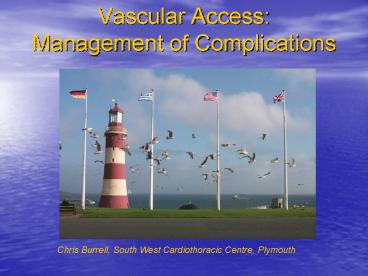Vascular Access: Management of Complications PowerPoint PPT Presentation
1 / 31
Title: Vascular Access: Management of Complications
1
Vascular AccessManagement of Complications
Chris Burrell, South West Cardiothoracic Centre,
Plymouth
2
Alternative Vascular Access Sites
- Femoral
- Axillary
- Brachial
- Radial
- Ulnar
Femoral v Radial
3
Vascular Complications Definitions
Major
- Bleeding requiring transfusion
- Complication requiring surgical repair
- Exclude thrombosis/thrombotic occlusion
Minor
4
Diagnostic Cardiac Catheterisation 1992-1997
Femoral Brachial
Radial n2000
n1966 n27
n7
Surgical vascular complication 5
(0.25) Non-surgical vascular complication
10 (0.5) Large Haematoma 4 False Aneurysm
4 Re-bleed 1 Entry site infection
1
Papaconstantinou H, Marshall A, Burrell C. Heart
199981465-9
5
Coronary Angiography with Peripheral Vascular
Disease
Femoral Brachial/Radial n297
n154 n143 p Value
Major vascular complications 6
0 lt0.01 Success Rate ()
79 91
lt0.01 Procedure Duration () 42/-22
51/-19 lt0.01 Radiation Dose (CGy)
41/-25 47/-26 0.03
Hilldick-Smith DJR et al Cathet Cardiovasc
Intervent 20004932-7
6
ACCESS A Randomised Comparison of PTCA by the
Femoral, Brachial and Radial Approaches
6F Femoral Brachial Radial
n900
n300 n300 n300
Major entry site complications () 2.0
2.3 0 Successful coronary
cannulation () 99.7 95.7
93.0 Primary PTCA success ()
90.7 90.7 91.7 Asymptomatic
occlusion -
- 3.0
Kiemeneij et al JACC 1997291269-75
7
Major Vascular Complications for PCI
Access Site Major Vascular
Thrombotic
Complication Occlusion
Femoral Compression 2 - 4 Device
Closure 1.2 - 2.8 Brachial
2 - 3 Radial 0.1
3 5
Cremanasi J Invas Cardiol 199410464 Kussmaul
JACC 1995251685 Sanbourn JACC
1993221272 Ernst JACC 199321851 Ellis Circ
1999100I-313
Benit et al CCD 199741124-30 Kiemeneij et al
JACC 1997291269 Shrake et al Am J Cardiol
2000851024 Mann T et al JACC 199832572 Cathete
r Cardiovasc Intervent 199740156
8
Vascular Complications Mechanisms
Intravascular
- Spasm
- Dissection
- Stenosis
- Thrombosis/Occlusion
- Rupture
- AV Fistula
- Bleeding/Haematoma
- False Aneurysm
Extravascular
9
(No Transcript)
10
(No Transcript)
11
Avoiding Radial Spasm
- Keep patient warm and hydrated
- Use anxiolytics
- Minimise manipulation and trauma
- Use hydrophilic sheaths
- Use vasodilators
- (Apply warm saline bag)
- Use coronary (014) guidewire
- Be prepared to use femoral approach
12
Avoiding Radial Occlusion
- Diabetes Mellitus
- Sheath size gt Vessel size
- Gender Female 80
- Male 18
- Heparin 3-5000 units
Nagai et al Am J Cardiol 199983180
Eur Heart J 199516293 Cath Cardiovasc
Intervent 199946173
13
Treating Radial Occlusion
- Conservative
- Local Thrombolysis
- Percutaneous Intervention
- Surgery
14
(No Transcript)
15
(No Transcript)
16
(No Transcript)
17
(No Transcript)
18
Vascular Complications Mechanisms
Intravascular
- Spasm
- Dissection
- Stenosis
- Thrombosis/Occlusion
- Rupture
- AV Fistula
- Haematoma/Bleeding
- False Aneurysm
Extravascular
19
Femoral Approach
- Puncture Common Femoral Artery
- Train Manual or Device (e.g. Femostop)
Compression - Avoid
- Use Closure Devices
- Obesity
- Systemic anticoagulation
- GP IIb/IIIa inhibitors
EPIC NEJM 1994330956 EPILOG NEJM
19973361689 Pursuit NEJM 1998339436
20
Femoral Angiography Prior to Angioseal Deployment
n81
300 RAO 200 Caudal
Talwar S et al Int J Cardiovasc Intervent
2001422
21
Outside Manufacturers Recommendations
1. Low Puncture 5 (8) SFA 3 PF 2 Not
deployed successfully
2. Bifurcation Puncture 17 (19)
3. PVD 21 (32) All deployed successfully
22
False Aneurysm Sac
Femoral Artery
23
Spontaneous Closure of Selected Iatrogenic
Pseudoaneurysms and Arteriovenous Fistulae
n286 (196 pseudoaneurysms, 81 arteriovenous
fistulae, 9 mixed lesions)
diagnosed by Duplex scan
147 managed without surgery 86 resolved without
limb threatening complication 14 eventually
required surgical closure
Toursarkissian et al J Vasc Surg 199725803
24
Ultrasound Compression of Iatrogenic False
Aneurysms
- Introduced 1991
- Treatment of choice
- Painful and time-consuming, especially if
anticoagulants
Fellmeth B et al. Radiology 1991178671.
25
Ultrasound Guided Percutaneous Thrombin Injection
Treatment of Iatrogenic False Aneurysms
n1 (axillary false aneurysm)
Elford J, Burrell C, Roobottom C Heart
199982526.
Loose HW, Haslam PJ. Br J Radiol
1998711255. Kang SS, Labropoulos N et al J Vasc
Surg 1998271032. Liau CS, Ho FM, Chen MF J Vasc
Surg 19972618
26
(No Transcript)
27
xxxxxxxxxxx
False Aneurysm Sac
Femoral Artery
28
Human Thrombin Injection for Iatrogenic
Pseudoaneurysms
n14 (10 CFA, 3 SFA, 1 Ax )
Size 2.5-7.5 cm
1000 IU Human Thrombin under ultrasound
guidance Repeat colour Doppler at 24h
14/14 occluded at 24h 2
additional balloon inflation across neck 2
required 2nd injection
Elford J, Burrell C, Freeman S, Roobottom C.
Clin Rad 2001
29
Managing Pseudoaneurysms (and Arterio-venous
Fistulae)
- Conservative (2-4/52 if small asymptomatic)
- Ultrasound-Guided Compression
- Human (or Recombinant) Thrombin Injection
- Coil Embolisation
- Stent Graft
- Surgical Repair
30
Transradial Transfemoral
- Positive Allens
- Obesity
- Anticoagulants
- ThrombolysisIIb/IIIa
- Peripheral Vasc Dis
- Dilated Aortic Root
- Use Heparin
- (3-5000 units)
- Negative Allens
- Diabetes Mellitus
- Small Vessel/Large Sheath
- Anxious/Young/Female
- Tortuous Anatomy
- Grafts (LIMA)
- Use Closure Device
- (Femoral angiogram?)
31
Conclusions
- Radial approach offers advantages
- but not in all patients nor in all circumstances
- Straightforward technique but learning curve
- Best way to manage complications is to avoid them
- Involves familiarity with both techniques
combined with flexibility
- Next generation will use radial approach

